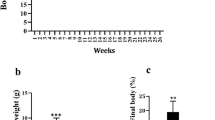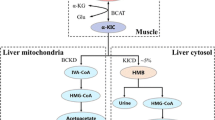Abstract
A sucrose-rich diet (SRD) induces insulin resistance and dyslipidemia with impaired hepatic glucose production and gluconeogenesis, accompanied by altered post-receptor insulin signaling steps. The aim of this study was to examine the effectiveness of fish oil (FO) to reverse or improve the impaired hepatic glucose metabolism once installed in rats fed 8 months a SRD. In the liver of rats fed SRD in which FO replaced corn-oil during the last 2 months, as dietary fat, several key enzyme activities and metabolites involved in glucose metabolisms (phosphorylation, glycolysis, gluconeogenesis and oxidative and non oxidative glucose pathway) were measured. The protein mass levels of IRS-1 and αp85 PI-3K at basal conditions were also analyzed. FO improved the altered activities of some enzymes involved in the glycolytic and oxidative pathways observed in the liver of SRD fed rats but was unable to restore the impaired capacity of glucose phosphorylation. Moreover, FO reversed the increase in PEPCK and G-6-Pase and reduced the G-6-Pase/GK ratio. Glycogen concentration and GSa activity returned to levels similar to those observed in the liver of the control-fed rats. Besides, FO did not modify the altered protein mass levels of IRS-1 and αp85 PI-3K. Finally, dietary FO was effective in reversing or improving the impaired activities of several key enzymes of hepatic carbohydrate metabolism contributing, at least in part, to the normalization of plasma glucose levels in the SRD-fed rats. However, these positive effects of FO were not observed under basal conditions in the early steps of insulin signaling transduction.


Similar content being viewed by others
Abbreviations
- AKt:
-
Serine/threonine protein kinase
- AMPKα2:
-
AMP activated kinase isoform
- C:
-
Cholesterol
- CD:
-
High starch diet
- ChREBP:
-
Carbohydrate response element binding protein
- CO:
-
Corn oil
- DAGT:
-
Diacylglycerol acyltransferase
- FFA:
-
Unesterified fatty acids
- FO:
-
Fish oil
- G-6-Pase:
-
Glucose-6-phosphate phosphatase
- GK:
-
Glucokinase
- Glucose-6-P:
-
Glucose-6-phosphate
- Glut2 and Glut4:
-
Glucose transporters 2 and 4
- GSa:
-
Glycogen synthase a
- HK:
-
Hexokinase
- IRS:
-
Insulin receptor substrate
- JNK:
-
c-jun N terminal kinase
- LXR:
-
Liver X receptor
- PDHa:
-
Pyruvate dehydrogenase active form
- PDHc:
-
PDH complex
- PEPCK:
-
Phosphoenolpyruvate carboxykinase
- PI-3K:
-
Phosphoinositide-3 kinase
- PK:
-
Pyruvate kinase
- PPARα:
-
Peroxisome proliferators activated receptor α
- PUFA:
-
Polyunsaturated fatty acid(s)
- SRD:
-
Sucrose rich diet
- TAG:
-
Triacylglycerol(s)
References
Wei Y, Wang D, Topczewski F, Pagliassotti MJ (2007) Fructose-mediated stress signaling in the liver: implication for hepatic insulin resistance. J Ntr Biochem 18:1–9
Bezerra RMN, Ueno M, Silva MS, Tavares DQ, Carvalho CRO, Saad MJA (2000) A high fructose diet affects the early steps of insulin action in muscle and liver of rats. J Nutr 130:1531–1535
Bisschop PH, de Metz J, Ackermans MT, Endert E, Pijl H, Kuipers F, Meijer AJ, Sauerwein HP, Romijn J (2001) Dietary fat content alters insulin-mediated glucose metabolism in healthy men. Am J Clin Nutr 73:554–559
Anai M, Funuaki M, Ogihara T, Kanda A, Onishi Y, Sakoda H, Inukai K, Nawano M, Fukushima Y, Yazaki Y, Kikuchi M, Oka Y, Asano T (1999) Enhanced insulin stimulated activation of phosphatidylinositol 3 kinase in the liver of high-fat fed rats. Diabetes 48:158–169
Bizeau ME, Pagliassotti MJ (2005) Hepatic adaptation to sucrose and fructose. Metabolism Clin Exp 54:1189–1201
Bizeau ME, Thresher JS, Pagliassotti M (2001) Sucrose diets increase glucose-6-phosphatase and glucose release and decrease glucokinase in hepatocytes. J Appl Physiol 91:2041–2046
Libal-Weksler Y, Gotlibovitz O, Stark AH, Madar A (2001) Diet and diabetic state modify glycogen synthase activity and expression in rat hepatocytes. J Nutr Biochem 12:455–464
Pagliassotti MJ, Kang J, Thresher JS, Sung CK, Bizeau ME (2002) Elevated basal PI-3kinase activity and reduced insulin signaling in sucrose-induced hepatic insulin resistance. Am J Physiol Endocrinol Metab 282:E170–E176
Wei Y, Pagliassotti MJ (2004) Hepatospecific effects of fructose on c-junc NH2-terminal kinase: implications for hepatic insulin resistance. Am J Physiol Endocrinol Metab 287:E926–E933
Storlien LH, Jenkins S, Chisholm DJ, Pascoe WS, Khouri S, Kraegen EW (1991) Influence of dietary fat composition on development of insulin resistance in rats. Relationship to muscle triglyceride and omega-3-fatty acids in muscle phospholipids. Diabetes 40:280–289
Lombardo YB, Chicco A (2006) Effect of dietary polyunsaturated fatty acids on dyslipidemia and insulin resistance in rodents. J Nutr Biochem 17:1–13
Carpentier YA, Portois L, Malaisse WJ (2006) N-3 fatty acids and the metabolic syndrome. Am J Clin Nutr 83(suppl):14995–15405
Fedor D, Kelley DS (2009) Prevention oil insulin resistance by n-3 polyunsaturated fatty acids. Curr Opin Clin Nutr Metab Care 12:138–146
Taouis M, Dagou C, Ster C, Durand G, Pinault M, Delarue J (2002) N-3 polyunsaturated fatty acids prevent the defect of insulin receptor signaling in muscle. Am J Physiol Endocrinol Metab 282:E664–E671
Ghafoorunissa, Ibrahim A, Rajkumar L, Acharya V (2005) Dietary (n-3) long-chain polyunsaturated fatty acids prevent sucrose-induced insulin resistance in rats. J Nutr 135:2634–2638
Lombardo YB, Chicco A, D’Alessandro ME, Martinelli M, Soria A, Gutman R et al (1996) Dietary fish oil normalizes dyslipidemia and glucose intolerance with unchanged insulin levels in rats fed a high sucrose diet. Biochim Biophys Acta 1299:175–182
Rossi A, Lombardo YB, Chicco A (2010) Lipogenic enzyme activities and glucose uptake in fat tissue of dyslipemic, insulin-resistant rats. Effects of fish oil. Nutrition 26:209–217
Podolin DA, Gayles EC, Wei Y, Thresher JS, Pagliassotti J (1998) Menhaden oil prevents but does not reverse sucrose-induced insulin resistance in rats. Am J Physiol Regulatory Integ Comp Physiol 274:R840–R848
Jump DB, Botolin D, Wang Y, Xu J, Christian B, Demeure O (2005) Fatty acid regulation of hepatic gene transcription. J Nutr 135:2503–2506
Hein G, Bernasconi AM, Montanaro MA, Pellon-Maison M, Finarelli G, Chicco A, Lombardo YB, Brenner RR (2010) Nuclear receptors and hepatic lipidogenic enzyme response to a dyslipidemic sucrose-rich diet and its reversal by fish oil n-3 polyunsaturated fatty acids. A J Physiol Endocrinol Metab 298:E429–E439
Liimatta M, Towle HC, Clare S, Jump DB (1994) Dietary polyunsaturated fatty acids interfere with the insulin/glucose activation of L-type pyruvate kinase gene transcription. Mol Endocrinol 8:1147–1153
Jump DB, Clarke SD, Thelen A, Liimatta M (1994) Coordinate regulation of glycolytic and lipidogenic gene expression by polyunsaturated fatty acids. J Lip Res. 35:1076–1084
Dentin R, Benhamed F, Pegorier JP, Foufelle F, Viollet B, Vaulont S, Girard J, Postic C (2005) Polyunsaturated fatty acids suppress glycolytic and lipogenic genes through the inhibition of ChREBP nuclear protein translocation. J Clin Invest 115:2843–2854
Lombardo YB, Chicco A, D’Alessandro ME, Martinelli M, Soria A, Gutman R et al (1996) Dietary fish oil normalize dyslipidemia and glucose intolerance with unchanged insulin levels in rats fed a high sucrose diet. Biochim Biophys Acta 1299:175–182
Chicco A, Soria A, Fainstein-Day P, Gutman R, Lombardo YB et al (1994) Multiphasic metabolic changes in the heart of rats fed a sucrose-rich diet. Horm Metab Res 26:397–403
Herbert V, Lau KS, Gottlieb CH, Bleicher S et al (1995) Coated charcoal immunoassay of insulin. J Clin Endocrinol Metab 25:1375–1384
Eggleston LV (1974) d-fructose-1-phosphate. In: Bergmeyer HU (ed) Methods of enzymatic analysis, 2° English edition. New York Academic Press, pp 1308–1313
Barzilai N, Rossetti L (1993) Role of glucokinase and glucose-6-phosphatase in the acute and chronic regulation of hepatic glucose fluxes by insulin. J Biol Chem 268:25019–25025
Harper AE (1963) Glucose-6-phosphatase. In: Bergmeyer HU (ed) (1974) Methods of enzymatic analysis. New York Academic Press, pp 788–792
Fiske CH, Subbarow P (1925) The colorimetric determination of phosphorus. J Biol Chem 66:375–400
Blakely SR, Hallfrisch J, Reiser S, Prather ES (1981) Long-Term effects of moderate fructose feeding on glucose tolerance parameters in rats. J Nutr 111:307–314
Petrescu I, Bojan O, Saied M, Barzu O, Schmidt F, Kühnle HF (1979) Determination of phosphoenolpyruvate carboxykinase activity with deoxyguanosine-5′-diphosphate as nucleotide substrate. Anal Biochemistry 96:279–281
Osterman J, Fritz PJ, Wuntch T (1973) Pyruvate kinase isozymes from rat tissues. J Biol Chem 248:1011–1018
D’Alessandro ME, Chicco A, Karabatas L, Lombardo YB et al (2000) Role of skeletal muscle on impaired insulin sensitivity in rats fed a sucrose rich diet. Effect of moderate levels of dietary fish oil. J Nutr Biochem 11:273–280
Zhang X, Liang W, Mao Y, Li H, Yang Y, Tan H (2009) Hepatic glucokinase activity is the primary defect in alloxan-induced diabetes of mice. Biomed Pharmacother 63:180–186
Snedecor GWP, Cochran WG (1967) Statistical methods applied to experimental in agriculture and biology. (Ames, IA). University Press Iowa State, USA
Shin JS, Torres TP, Catlin RL, Donahue EP, Masakazui S (2007) A defect in glucose-induced dissociation of glucokinase from the regulatory protein in Zucker diabetic fatty rats in the early stage of diabetes. Am J Physiol Regulatory Integrative Comp Physiol 292:1381–1390
Delarue J, LeFoll C, Corporeau C, Lucas D (2004) N-3 long chain polyunsaturated fatty acids: a nutritional tool to prevent insulin resistance associated to type 2 diabetes and obesity? Reprod Nutr Dev 44:289–299
Lemaigre FP, Rosseau GG (1994) Transcriptional control of genes that regulate glycolysis and gluconeogenesis in adult liver. Biochem J 303:1–14
Munnich A, Lyonnet S, Chauvet D, Van Scaftingen E, Kahn A (1987) Differential effects of glucose and fructose on liver L-type pyruvate kinase gene expression in vivo. J Biol Chem 262:17065–17071
Da Silva LA, De Marucci OL, Kuhnle ZR (1993) Dietary polyunsaturated fats suppress the high-sucrose-induced increase of rat liver pyruvate dehydrogenase levels. Biochim Biophys Acta 1169:126–134
Sommercorn J, Freedland RA (1984) Effects of diets on concentrations of 6-phosphogluconate and fructose 2,6-bisphosphate in rat livers and an assay of fructose 2,6-bisphosphate with an improved method. J Nutr 114:1462–1469
Higuchi T, Shirai N, Saito M, Suzuki H, Kagawa Y (2008) Levels of plasma insulin, leptin and adiponectin, and activities of key enzymes in carbohydrate metabolism in skeletal muscle and liver in fasted ICR mice fed dietary n-3 polyunsaturated fatty acids. J Nutr Biochem 19:577–586
Neschen S, Morino K, Dong J, Wang-Fisher Y, Cline GW, Romanelli AJ, Rossbacher JC, Moore IK, Regittnig W, Munoz DS, Kim JH, Shulman GI (2007) N-3 fatty acids preserve insulin sensitivity in vivo in a peroxisome proliferators-activated receptor-α-dependent manner. Diabetes 56:1034–1047
Gerfely P, Toth B, Farkas I (1985) Bot G (1985) Effect of fructose 1-phosphate on the activation of liver glycogen synthase. Biochem J 232:133–137
Klimes I, Sebokova E, Vrana A, Kazdova L (1993) Raised dietary intake of N-3 polyunsaturated fatty acids in high sucrose-induced insulin resistance: animal studies. Ann N Y Acad Sci 683:69–81
Corporeau C, Le Foll C, Taouis M, Gouygou JP, Bergé JP, Delarue J (2006) Adipose tissue compensates for defect of phosphatidylinositol-3′-kinase induced in liver and muscle by dietary fish oil in fed rats. Am J Physiol Endocrinol Metab 290:E78–E86
Acknowledgments
This study was supported by Grants PICT 05-38157 BID 1728 OC/AR and PIP # 11220090100105, 2010 from the Agencia Nacional de Promoción Científica y Tecnológica and CONICET.
Author information
Authors and Affiliations
Corresponding author
About this article
Cite this article
Hein, G.J., Chicco, A. & Lombardo, Y.B. Fish Oil Normalizes Plasma Glucose Levels and Improves Liver Carbohydrate Metabolism in Rats Fed a Sucrose-Rich Diet. Lipids 47, 141–150 (2012). https://doi.org/10.1007/s11745-011-3623-4
Received:
Accepted:
Published:
Issue Date:
DOI: https://doi.org/10.1007/s11745-011-3623-4




